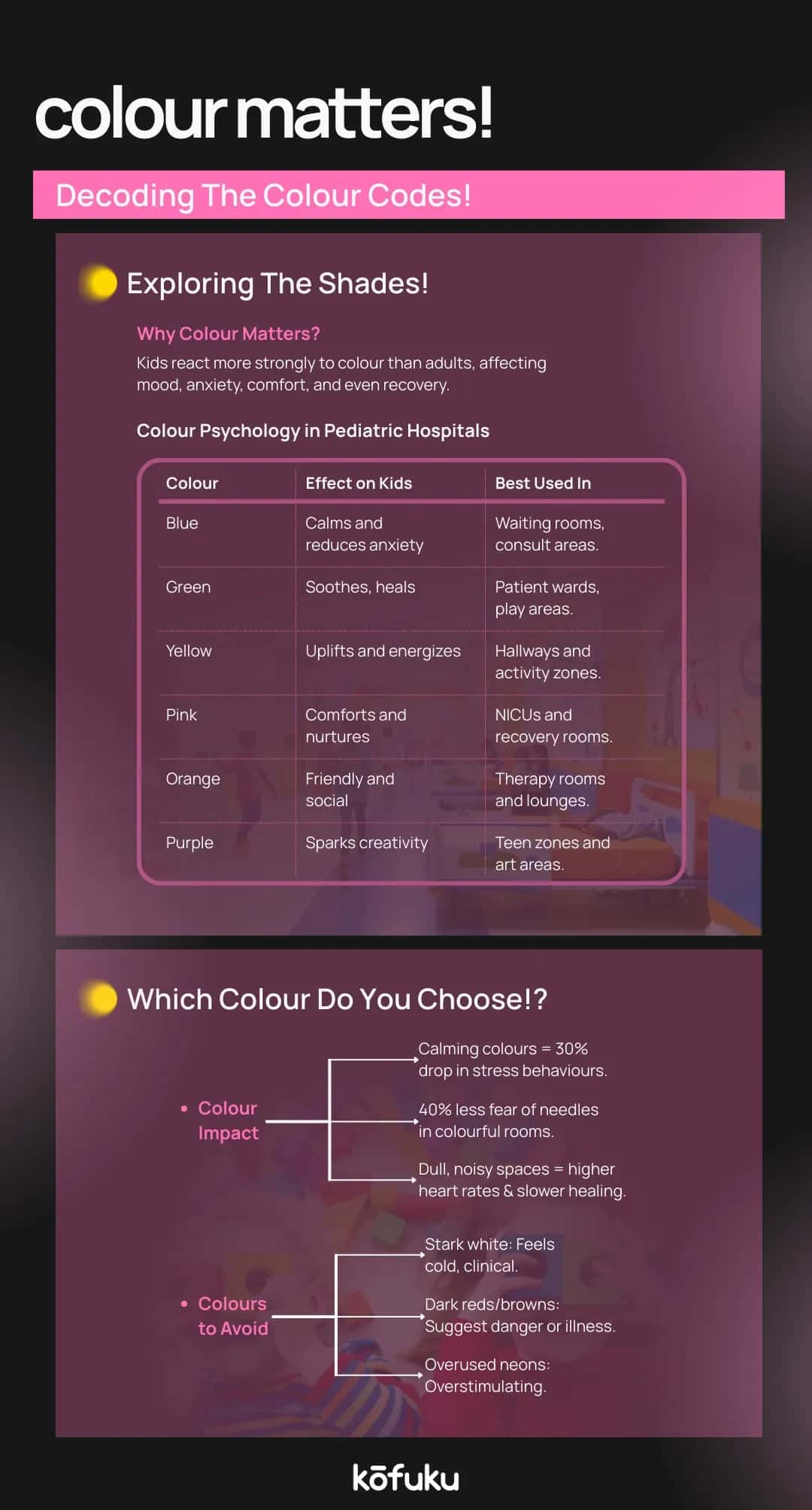Brighter Spaces: How Colours Can Make Hospitals Less Daunting For Children


Introduction
Hospitals can be overwhelming and scary, even for adults, so think about how it must be for children. For most children, hospitals are scary places, and their brain naturally associates them with negativity.
There are new faces, smells, sounds, and new walls. Just the thought of whitewashed hospital corridors or the buzz of fluorescent lights and sick people can make kids anxious, creating feelings of discomfort and fear.
Research shows that colour psychology plays a pivotal role in creating a healing environment for children.
One of the reasons for this is that colours have a significant psychological effect on mood and emotional state. Moreover, the connection between colour and mood for children is even more powerful.
So, when hospitals purposefully choose to have colour inside their buildings, they can create an environment that is more welcoming and calming, putting young patients and other children visiting the hospital at ease.
This article will discuss how adding more colour can contribute towards creating more child-friendly hospitals, describing practical design techniques and ideas, and providing valuable knowledge that would help elevate our hospitals.
Creating Comfort Through Colours
The days of hospitals looking like something out of a science fiction movie, with bare white walls and dreadful fluorescent lighting, are over!
Experts, including designers of paediatric facilities, suggest that colour is more important than ever to promote a more positive and healing environment for children.
In fact, according to colour psychology, colours can bring about different emotional responses. For instance:
-
Warm colours like pinks, oranges, and sunshine-yellow all bring a sense of warmth, comfort, and cheer.
-
Cool colours like blues and greens are associated with calmness. They help lower stress and provide a relaxed setting.
-
Bright colours can energise patients or distract them, which is particularly beneficial for children, whereas pastel colours are known to have a soothing effect.
Colours aren’t just meant to be a decorative element. Paediatric psychologists believe that colours can truly have a healing effect. For example, a room painted blue or mint green could help alleviate a child's anxiety before surgical procedures, while a room with playful patterns and murals in full view can serve as a mental escape or distraction for children.
Today, hospitals worldwide are beginning to embrace these concepts, and the results are amazing! Waiting areas adorned with sunshine-yellow walls or patients' rooms that embrace soft lilac or sea-foam green all contribute to a less scary experience for young patients and children visiting the hospital.
There are also children’s hospitals that have fun play areas bursting with tangerine and turquoise colours, which help decrease a child’s feeling of separation from the outside world.
Some hospitals are also moving beyond simple wall colours and are integrating sensory design ideas. This includes adding tactile elements to walls, interactive light art, and using LED lights that change colour throughout the day.
Designs like these not only make a place feel alive but also regulate children's circadian rhythm to help them sleep and be more comfortable.

Inspiration from a Young Girl’s Colourful Imagination
Sometimes, change can emerge from the most unexpected places. Aadya Kapoor's project, 'Colours Create Comfort,' started when she saw a mother consoling her child in a bare, dull waiting room.
In that moment, she realised how much colour, design, and art could relieve hospital stress and help people feel more at ease.
She teamed up with schools and organisations to collect colourful art to decorate the empty walls at hospitals like Ram Manohar Lohia (RML) Hospital and Deen Dayal Upadhyaya Hospital.
Aadya's project completely changed the atmosphere and mood of the hospital's once-boring walls and corridors, creating a cheerful and bright place for children.
Doctors from RML told Aadya that gathering and displaying art in the hospital helped both the children and parents, as they had something else to focus on.
According to Kapoor, while non-medical professionals can’t cure a patient, they can help by creating a pleasant environment in the hospitals, and she was successful in doing that with the help of one colourful art piece at a time.
Breaking the Monotony of Hospital Walls
Hospitals feel morbid and depressive; this is something that many people around the world would agree with, and bland, white, and grey, sterile environments that exude an air of seriousness don’t exactly help with this. Instead, these environments just intensify feelings of loneliness, sadness, or fear, especially in young patients.
Paediatric professionals understand the fact that colour is not simply an aesthetic concept, but a patient-centred psychological concept that can alter the moods and mindsets of adults and children alike.
This does not mean that hospitals should not be sterile or simple, just that they shouldn’t look like some evil scientist’s lab where children are sacrificed, and a little pop of colour would go a long way to achieve that.
Children often describe hospitals as "boring" or "scary." However, if hospitals incorporate colour and art into their environment, the same children may feel much happier, less scared, and more in control of their surroundings.

Some hospitals contain:
-
Creative and functional nature murals, featuring forests, oceans, or animals, are designed to engage children's curiosity and provide a sense of comfort.
-
Walls featuring interactive textures and colours that children can explore.
-
Coloured Zones that use paint to mark multiple areas of the building, helping children navigate more easily.
These minor elements significantly impact children's experiences in the hospital, help reduce stress, and make children more cooperative, which in some cases can lead to faster recovery.
Winston Churchill’s Wise Words
Winston Churchill once said, “We shape our buildings; thereafter they shape us.” His statement rings true, even for hospital designs. Hospitals don’t have to be ominous; instead, they can be a place of solace and hope for children.
By investing in vibrant, soothing, and whimsical environments, hospitals can transform the way children interact with their surroundings.
Design choices, no matter how small, can have a massive impact, such as:
- Less distress during checkups and procedures in the hospital.
- Better attitude and cooperation.
- Positive relationships and trust in the medical staff.
- Better memories about going to the hospital.
Conclusion
As we understand more about the intimate connection between how colours can change the environment and impact wellbeing, we also learn that colours are about more than trends; they support the health of the mind, body, and soul.
Colours have a healing effect, whether it's a warm yellow wall that reminds a child of sunshine or a peaceful green room that calms a child’s fear.
Simple changes, such as adding murals and being creative with colours, can transform cold clinic or hospital walls into a space where children feel happy, safe, and cared for, making healthcare facilities less like institutions of care and more like sanctuaries of healing.

FAQs
Q. Why do colours matter in paediatric hospital design?
A. Colours help create a calm, friendly space that can reduce fear and allow children to feel at ease. All in all, bright colours have a positive impact on emotional state and perception of the environment.
Q. What colours are considered most soothing for children in hospitals?
A. Soft blues, greens, and pastels are calming colours. These colours instil a sense of calmness and also help reduce anxiety in children.
Q. Can certain colours reduce anxiety in child patients?
A. Yes, calming, soothing colours like blue and green can alleviate stress, lessen anxiety, and produce emotional comfort in children.
Q. Are there any colours hospitals should avoid using around kids?
A. Harsh reds or yellows, extremely bright neon, or any boring, dull grey can create anxiety or discomfort for children and should be avoided wherever possible.
Q. How does colour psychology affect healing in children?
A. Colour psychology creates an environment conducive to good mood, stress reduction, and positively affects recovery speed through relaxation and comfort.

10 Medical Equipment That Must Be Kept at Home

10 Health Benefits of Reflexology You Should Know

10 Health Benefits of Apple Cider Vinegar You Should Know

13 ways to get rid of menstrual cramps

Children’s Health Tips for Daycare Safety & Wellness

How Illness Affects Children's Emotions: A Parental Guide

Parenting Gifted Kids: Nurturing Talented Children

